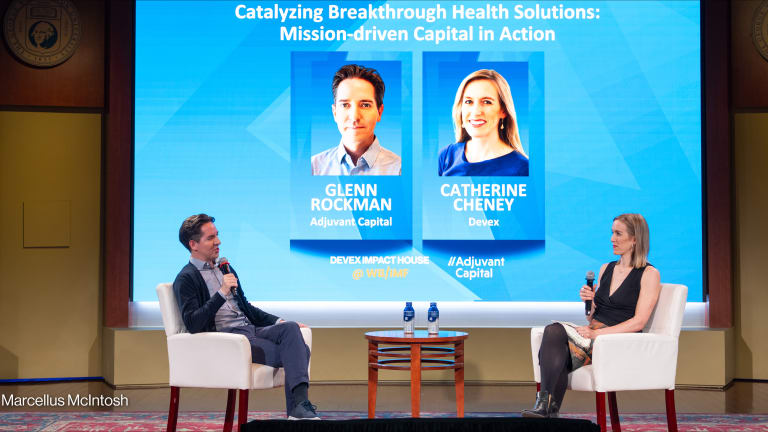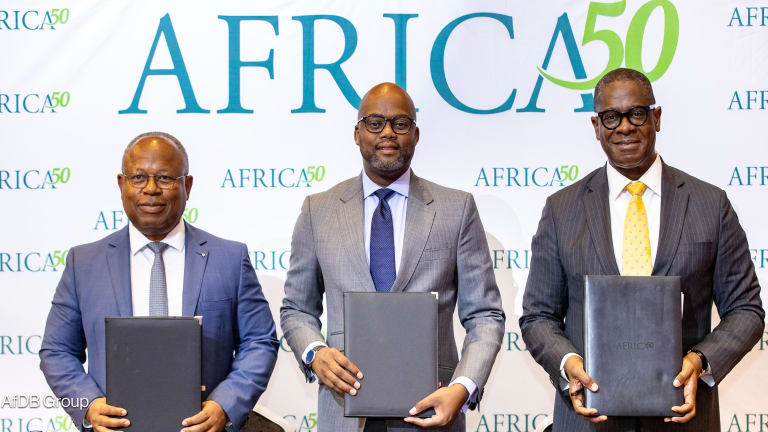
SAN FRANCISCO — Investors are not always sure how to contribute to the Sustainable Development Goals. While some may just slap an SDG logo on their efforts, others are seeking guidance to confirm they are driving impact.
A startup within the United Nations Development Programme is developing new tools to eliminate key barriers to SDG-enabling investment. Launched in September 2018, SDG Impact is now prototyping the new approaches it has developed across six geographies.
Elizabeth Boggs Davidsen, director of SDG Impact, spoke with Devex at the Social Capital Markets conference in San Francisco last week about the progress of these efforts to channel private investment toward the Global Goals.
This conversation has been edited for length and clarity.
“Achieving the SDGs is not about money.”
— Elizabeth Boggs Davidsen, director, SDG ImpactYou were also here at SOCAP in 2018, a month after the launch of SDG Impact, to talk about the model. What challenges have you faced over the past year?
It’s taken longer than I expected. The way this works at UNDP was unusual. I was hired to run a startup out of the executive office to somehow crowd in capital for the achievement of the SDGs. It was a pretty broad mandate and I was given a short amount of time.
Private sector on a 'journey' to engagement with the SDGs
Where does business engagement with the Sustainable Development Goals stand? Here's what Devex found.
I started in March 2018 and by the end of September 2018, we launched this vision and the website. I asked the organization for some seed capital to develop these tools in 2019 so we could go to scale in 2020. I had a four-year vision for what it would take to see a significant difference and it’s taken a bit longer.
There is a lot of independent verification coming online, for example with the International Finance Corporation’s Operating Principles for Impact Management. But in the absence of knowing what you’re certifying to precisely, or being able to look under the hood as we say, it’s difficult to drive consistency, transparency, comparability.
We’ve developed the first set of standards for private equity, which we released last month and are open for public consultation. We’re releasing bond assurance standards in November and enterprise assurance standards in December. We’re trying to have a suite of assurance standards on the market for consultation.
We already have 50 firms or funds working with us to pilot. The next step is to develop the certification training we would license to these third parties. And soon, we’ll be working to develop an SDG Impact Seal that would be awarded based on compliance. It’s coming along. It’s on track. It’s just taking a bit longer. I was hopeful to have all standards down by now.
Here at SOCAP 2019, you spoke about ways SDG Impact is translating the data collected across the U.N. system into investible opportunity areas. Can you expand on that?
We developed this methodology, we’re codified it into SDG Impact country mapping reports, and we tested it in Brazil. We came up with 21 investment opportunity areas in Brazil that are quite specific and supported by 18 data points that would really help an investor.
For example, when you take a look at food and agriculture in Brazil, you start to understand that grain storage is an investment opportunity area. It’s the fourth-largest producer of grain in the world. Fifty percent of the grain is lost in transport. And so you have a tremendous need and opportunity to think about grain storage infrastructure.
We’re testing this in six different geographies this year where there’s a lot of interest and where we have some capacity: China, Colombia, Armenia, Jordan, South Africa, and Nigeria.
First, we want to nail some of the “how,” in terms of giving guidance on how to allocate capital. Second, we want to provide some insights into where there are investment opportunities. And the third piece will be the facilitation, which we haven’t started yet. Once you have an investor map, we organize an investment forum and create some of the needed matchmaking.
We will also be organizing some really structured policy dialogues. Through this map exercise, investors understand where there are enabling opportunities or gaps. These forums would bring together the supply and demand.
What are your goals a year from now? If you return for SOCAP 2020, what do you hope to report back?
For Pro subscribers: 4 years later, is it any easier to track the SDGs?
New data sources and a revamp of the U.N. High-level Political Forum could help monitor and assess progress on the SDGs. With lack of accurate data still hampering implementation, these changes can't come soon enough, development experts tell Devex.
I hope we will have done some really careful mapping of where there are investment opportunities in at least 20 countries. I’d like to be more ambitious, but I’m toning down my ambition.
We will have these assurance standards on the market. And we will have started to work through a certification process. And I hope we have a cohort of funds and firms complying with these assurance standards. Our whole vision for next year is really just to scale.
Of course, what SDG Impact is doing is only a part of the solution to drive more private capital toward the SDGs. What more is needed?
Every enlightened finance and business leader will say these Global Goals are our guideposts, yet the reality is there is very little SDG achievement when you think about global liquidity.
The need is to operationalize these goals, demonstrating in a consistent, transparent, comparable way our contribution to the SDGs. Reducing some of these key barriers is a huge driver in sort of seeing that sea change of investment around the SDGs.
We’re working on the “how.” But I think there’s some work to be done on the policy level more broadly to support the “why” of these goals. And that’s happening.
A lot of these conversations are about the lack of financing. Achieving the SDGs is not about money. As important as leveraging money is, it’s really about revisiting what Global Goals mean and how we can achieve them. You constantly hear about the challenges of accessing capital, and that’s not really the challenge with the SDGs. There’s plenty of liquidity to meet these goals immediately. But it’s really about helping investors think through how to allocate capital.
One of the reasons I’m excited about this program, even though it’s hard to do this in the U.N., is I really think it’s a game-changer if we can do this — if we can drive capital in ways that are meaningfully demonstrating and contributing to the goals.








